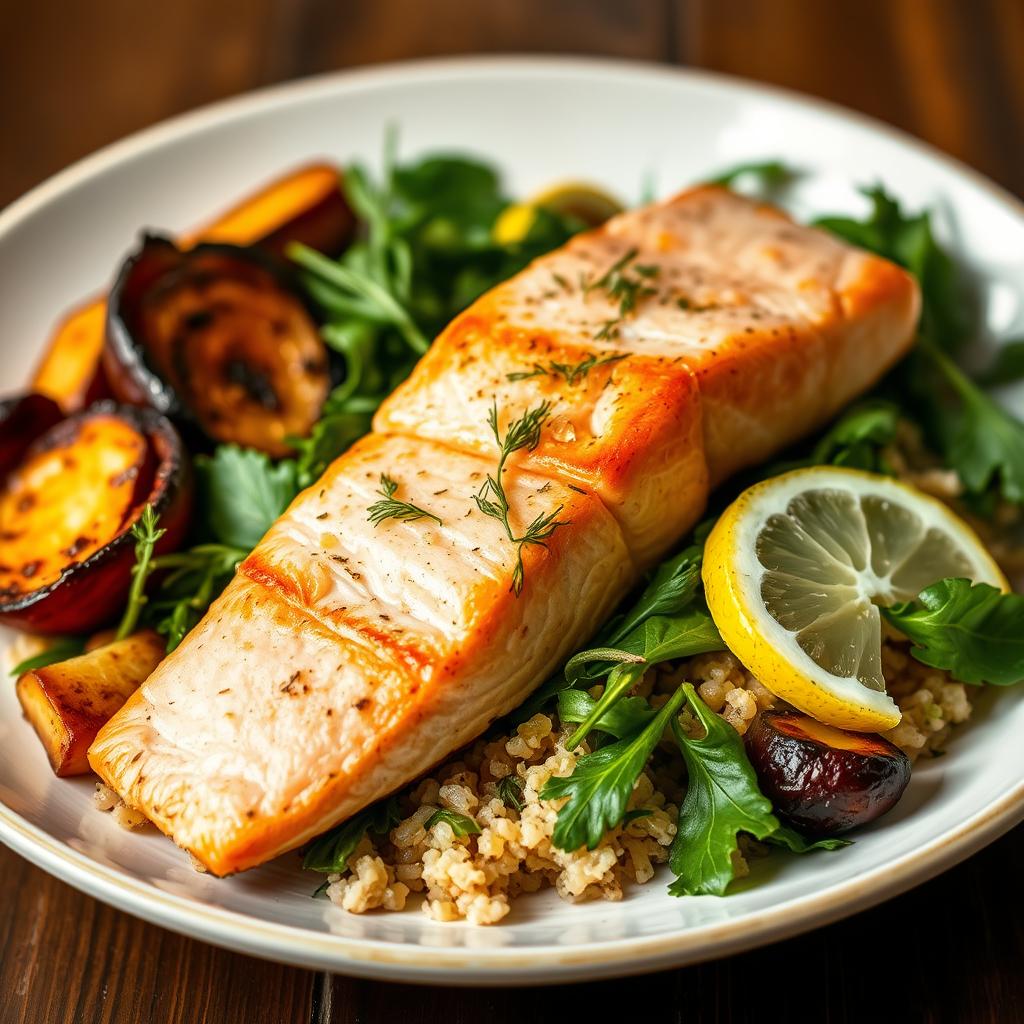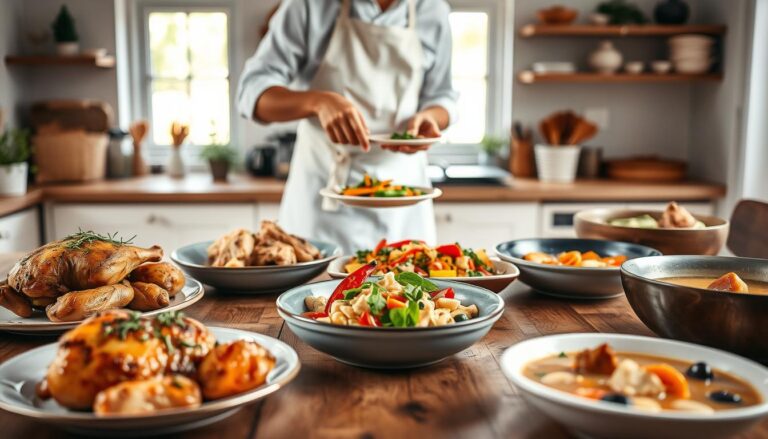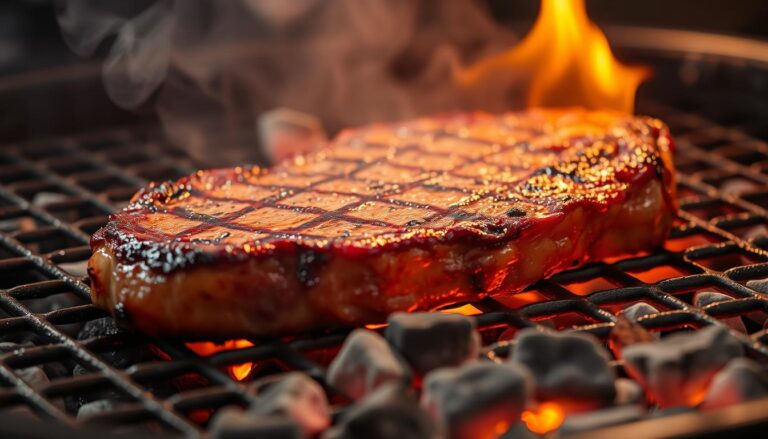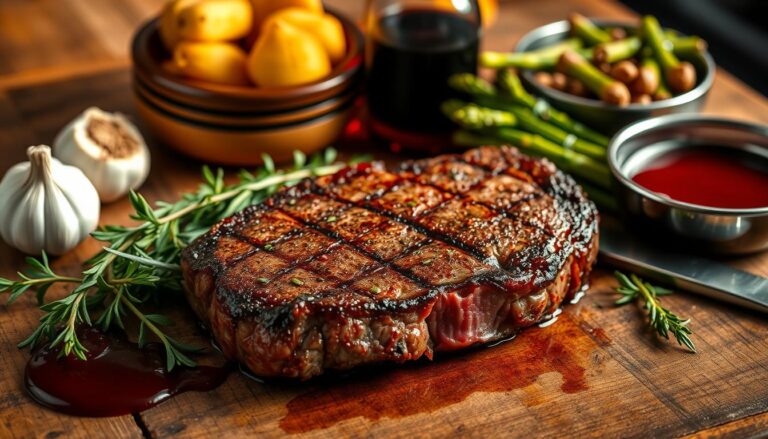Easy Salmon Recipes: 10 Delicious Salmon Dishes to Try
When I first learned about easy salmon recipes, my cooking world changed. What was once hard to make became my favorite quick dinner. It wowed my family and friends.
Salmon is amazing because it fits many cooking styles and tastes. It’s perfect for busy people, home cooks, or anyone wanting to make dinner better. These quick salmon dishes will change how you cook.
This guide shows ten tasty salmon recipes that are easy to make. You’ll learn how to bake, grill, pan-sear, or broil salmon. These methods make cooking salmon simple.
Key Takeaways
- Salmon offers incredible versatility in cooking methods
- Quick salmon dishes can be prepared in under 30 minutes
- Minimal ingredients are needed for delicious results
- Easy salmon recipes work for both weeknight dinners and special occasions
- Nutritional benefits make salmon a smart protein choice
Why Salmon is the Perfect Choice for Quick Meals
Salmon is a top pick for fast and healthy meals. It’s full of great health benefits and is very versatile. This fish can make your cooking exciting and easy.
Salmon is a nutritional powerhouse. It offers many nutrients that help keep you healthy.
Nutritional Powerhouse
- High-quality protein for muscle maintenance
- Rich in omega-3 fatty acids
- Excellent source of vitamin D
- Contains essential minerals like selenium
Time-Saving Preparation
Salmon is quick to prepare, so you can enjoy a fancy meal fast. Most recipes are done in under 15 minutes. This is great for people with busy lives.
| Cooking Method | Average Preparation Time |
|---|---|
| Baking | 15-20 minutes |
| Pan-Searing | 8-10 minutes |
| Grilling | 10-12 minutes |
Versatile Salmon Cooking Techniques
Salmon lets your creativity shine. Versatile salmon cooking methods include baking, grilling, broiling, and pan-searing. Each way adds different flavors and textures to your meals.
- Baking for hands-off preparation
- Grilling for smoky flavor
- Pan-searing for crispy exterior
- Broiling for quick, high-heat cooking
Salmon is ideal for anyone who wants tasty, quick, and healthy meals. It’s perfect for busy professionals or home cooks.
Essential Ingredients and Tools for Salmon Preparation
Preparing delicious salmon dishes needs the right ingredients and tools. Whether you’re cooking at home or dreaming of being a chef, knowing the essentials will make your salmon dishes better.
To make fresh salmon into a tasty meal, you need the right tools and seasonings. Your kitchen should have key equipment and flavor enhancers. This will help you make dishes that taste like they’re from a restaurant.
Must-Have Seasonings and Spices
For salmon, a few key seasonings can really boost the flavor:
- Sea salt and freshly ground black pepper
- Garlic powder for depth of flavor
- Dill for a classic herb touch
- Lemon pepper for zesty brightness
- Smoked paprika for a subtle smoky note
Kitchen Equipment You’ll Need
Here are the essential tools for cooking salmon:
- Sharp fillet knife for precise cutting
- Sturdy baking sheet with raised edges
- Instant-read meat thermometer
- Non-stick skillet or grill pan
- Silicone basting brush
Shopping Tips for Fresh Salmon Selection
Choosing high-quality fresh salmon is key for great taste. Look for salmon that’s bright, firm, and has little discoloration. Wild-caught salmon usually tastes better and is healthier than farm-raised.
Here are some tips for picking the best fresh salmon:
- Check for a clean, ocean-like smell
- Ensure flesh springs back when gently pressed
- Buy from reputable seafood markets
- Choose sustainably sourced options
By learning about these ingredients, tools, and selection tips, you’ll be ready to make amazing salmon dishes. These dishes will impress your family and friends.
Easy Salmon Recipes for Beginners
Starting with beginner salmon recipes might seem scary, but it’s easy once you know the basics. You don’t need to be a pro in the kitchen to make tasty simple salmon dishes. These easy methods will make you feel more confident and excited to cook.
Begin with basic seasoning tips to make salmon truly special. The key to great salmon is simple prep and choosing the right ingredients. Learning a few important principles is all you need to start cooking salmon.
- Choose fresh salmon fillets with bright color and firm texture
- Pat salmon dry before seasoning to ensure crispy exterior
- Use minimal ingredients for maximum flavor
For beginners, essential seasonings include:
- Olive oil as a base
- Sea salt and black pepper
- Dried herbs like thyme
- Garlic powder for depth
Try different spice mixes to make your own unique salmon dish. Add flavors like smoked paprika, chili powder, or cumin for a twist.
Don’t worry if it takes a few tries to get it right. Every time you cook salmon, you’ll get better. Start simple, trust your instincts, and enjoy the tasty results of your salmon cooking journey.
Baked Salmon with Garlic and Honey Glaze
Discover the ultimate baked salmon recipe that combines sweet and savory flavors in one delightful dish. This garlic honey salmon will transform your dinner routine with its simple yet elegant preparation.
Creating the perfect baked salmon recipe requires understanding a few key techniques. The right temperature and timing can make all the difference between a dry, tough fish and a succulent, flavorful meal.
Perfect Temperature Guidelines
When preparing your salmon temperature guide, keep these key points in mind:
- Preheat oven to 350°F for consistent cooking
- Bake a 3-pound fillet for approximately 25 minutes
- Check internal temperature reaches 145°F
- Salmon is done when it flakes easily with a fork
Sauce Variations
Elevate your garlic honey salmon with these delicious sauce alternatives:
- Classic Honey Garlic Glaze: Blend honey, minced garlic, soy sauce, and a touch of ginger
- Spicy Maple Variation: Mix maple syrup with red pepper flakes
- Herb-Infused Option: Combine honey with fresh thyme and rosemary
Serving Suggestions
Complement your baked salmon with these side dish recommendations:
| Side Dish | Flavor Profile | Preparation Time |
|---|---|---|
| Roasted Asparagus | Light and Crisp | 15 minutes |
| Quinoa Pilaf | Nutty and Wholesome | 20 minutes |
| Garlic Mashed Potatoes | Creamy and Rich | 25 minutes |
Pro tip: Let your salmon rest for 5 minutes after baking to ensure maximum juiciness and flavor distribution.
Pan-Seared Salmon with Lemon Butter Sauce
Making perfect pan-seared salmon is an art. It turns a simple fish into a top-notch meal. This recipe will teach you how to get a crispy outside and a soft, flaky inside.
Start by picking a high-quality salmon fillet with the skin on. Dry the salmon with paper towels for a crispy crust. Season it with kosher salt and black pepper to bring out the fish’s taste.
- Choose a cast-iron skillet or heavy-bottomed pan for even heat distribution
- Use neutral oil with a high smoke point like canola or grapeseed
- Cook skin-side down first to achieve a perfectly crispy texture
The lemon butter sauce makes this dish special. It’s made from melted butter, fresh lemon juice, and herbs. This mix adds a rich, tangy flavor to the salmon.
Cooking time is important for great results. Cook for 4-5 minutes on each side, depending on the fillet’s thickness. The salmon should be 145°F inside for safety and stay moist.
Pro tip: Let the salmon rest for 2-3 minutes after cooking. This lets the juices spread, making it more flavorful and tender.
Sheet Pan Salmon and Vegetables
Discover the magic of a one-pan salmon meal for your weeknight cooking. Sheet pan salmon makes dinner easy and flavorful. It’s great for busy cooks because it’s quick and has little cleanup.

Sheet pan salmon is simple and versatile. You can pick vegetables that go well with the fish. This makes your meal both tasty and easy to make.
Best Vegetable Combinations
Choosing the right vegetables is key for a great sheet pan salmon meal. Here are some top picks:
- Asparagus and cherry tomatoes
- Broccoli and bell peppers
- Zucchini and red onions
- Brussels sprouts and carrots
Seasoning Tips
To make your one-pan salmon meal even better, try these seasoning tips:
- Use fresh herbs like dill, parsley, or thyme
- Make a simple marinade with olive oil, lemon juice, and garlic
- Try spice blends like Mediterranean or Cajun
- Add honey or maple syrup for sweetness
Pro tip: Place vegetables around the salmon for even cooking. This ensures all parts are flavorful.
Grilled Salmon with Herb Marinade
Discover the best grilled salmon recipe for your outdoor cooking. Grilling salmon adds a smoky flavor that makes it even more delicious. The secret to a great herb-marinated salmon is in how you prepare and grill it.
First, get your ingredients ready for a tasty herb marinade:
- Fresh rosemary
- Thyme leaves
- Minced garlic
- Olive oil
- Lemon zest
- Sea salt
- Cracked black pepper
Make your marinade by mixing these ingredients and covering the salmon well. Let it sit for 20-30 minutes to soak up the flavors.
| Grilling Method | Temperature | Cooking Time |
|---|---|---|
| Direct Heat | 400-450°F | 4-6 minutes per side |
| Cedar Plank | 350-375°F | 10-12 minutes |
Grilling tip: Heat the grill and brush the grates with oil to avoid sticking. For cedar plank grilling, soak the plank in water for an hour. This prevents burning and adds a woody flavor to your salmon.
To check if the salmon is done, make sure it reaches 145°F inside. It should flake easily and look opaque.
Quick Broiled Salmon Recipes

Broiled salmon is a fast and tasty way to enjoy this healthy fish. With the right techniques, you can make a delicious meal in minutes. Broiling makes salmon crispy on the outside and tender inside.
To make broiled salmon, focus on flavor and keeping it moist. Quick salmon recipes using broiling are great for busy weeknights.
Broiling Techniques for Perfect Salmon
- Position the oven rack 4-6 inches from the heat source
- Pat salmon dry before seasoning to ensure crispy edges
- Use a high-quality baking sheet lined with foil for easy cleanup
- Brush salmon with olive oil to prevent sticking
Time and Temperature Guide
Getting broiled salmon right takes precision. Cooking times vary based on fish thickness. Here’s a quick guide for perfect salmon:
- Thin fillets (1/2 inch): 3-4 minutes
- Medium fillets (3/4 inch): 5-6 minutes
- Thick fillets (1 inch): 6-7 minutes
Pro tip: Keep an eye on your salmon to avoid burning. Aim for a golden-brown outside and a moist inside. Salmon is ready when it’s 145°F and flakes with a fork.
Try different seasonings like garlic, lemon, herbs, or honey glaze. This will make your broiled salmon dishes stand out and impress everyone.
Healthy Salmon Meal Prep Ideas
Salmon meal prep is a big help for those who are always on the go but want to eat well. Making salmon meals ahead of time saves time and ensures you eat tasty, healthy food every day.
Here are some tips for preparing healthy salmon meals:
- Cook salmon in batch portions
- Use airtight containers for storage
- Pair with nutrient-rich side dishes
- Plan for proper reheating techniques
Keeping salmon fresh and safe is key. Here’s a guide on how to store it:
| Storage Method | Duration | Recommended Conditions |
|---|---|---|
| Refrigerator | Up to 3 days | Sealed in airtight container |
| Freezer | Up to 4 months | Wrapped tightly in freezer-safe packaging |
For great meal prep, try these easy mixes:
- Baked salmon with quinoa and roasted vegetables
- Herb-crusted salmon with mixed green salad
- Asian-inspired salmon with brown rice and steamed broccoli
Pro tip: Divide your salmon and sides into individual containers. This makes for easy, healthy meals that fit your diet goals.
Conclusion
Exploring easy salmon cooking opens up a world of delicious possibilities for home chefs. The versatile salmon dishes we’ve explored show how simple it can be to create restaurant-quality meals at home. With these techniques, you’ll turn ordinary weeknight dinners into extraordinary culinary experiences.
Your salmon recipe collection now includes multiple cooking methods for different skill levels and taste preferences. From baking and pan-searing to grilling and broiling, you have a range of techniques to keep your meals exciting and nutritious. The health benefits of salmon combined with these straightforward recipes make it an ideal protein choice for anyone seeking quick, wholesome meals.
Remember, cooking salmon is about experimenting and finding your personal style. Don’t be afraid to mix marinades, try new seasonings, or adjust cooking times. Each recipe serves as a foundation for your culinary creativity. With practice, you’ll develop confidence in preparing salmon dishes that are both delicious and nutritionally balanced.
Your journey into salmon preparation has just begun. Embrace the simplicity, enjoy the process, and savor every bite of your delectable creations. These recipes are more than instructions—they’re an invitation to explore, learn, and delight in the art of cooking salmon.







